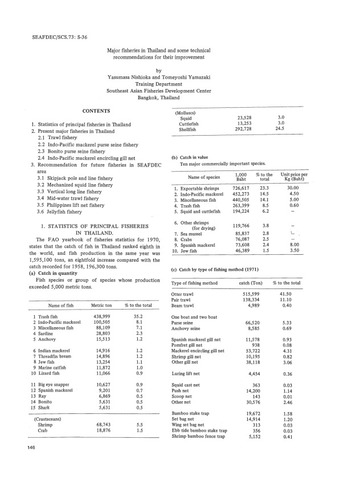Fishing Status of Thailand
Share
Abstract
Marine fishery of Thailand characterized as multi-species and multi-gear fishery. The continuous advances in fishing technology make marine production increasing annually that resulted in depletion of the stocks particularly in the Gulf of Thailand. Most of economically important species has been reported as overexploited or fully exploited. Approximate 90% of marine catch come from large scale fisheries. Trawlers, purse seines, drift gill nets, encircling gill nets regarded as important fishing gears practice. In 1994, total marine production (capture and culture) was 3,150,233 ton, comprised pelagic fish 953,907 ton, demersal fish 287,940 ton, miscellaneous fish 172,591 ton, crustaceans 437,508 ton, mollusk 281,611 ton, trash fish 930,546 ton and others 86,112 ton. The demersal resources are mostly caught by trawl net while pelagic caught mainly by purse seines and gill nets. Among these, trash fish accounted for 40% of total catch, of which more than 30% of the trash is juvenile and unsized economic fish. The major catch of trash fish comes from otter board trawl 75%, pair trawl 15%, purse seines 8%, push net 1%, and the rest is from other gears. The Department of Fisheries has implemented the strategy for responsible fisheries management and development on the basis of conservation and long-term sustainable fisheries in which environmental and ecological management is also taken into account. Fishery's regulations and notification are imposed on a fishery to achieve management and conservation objectives. The regulations that protect particular parts of the stocks are minimum mesh size to protect small individuals, closed season and area to protect juvenile and spawning stock, the restriction of the use of certain type of fishing and methodology in certain area. Other approaches are minimize number of fishing trawl vessel, ban the push net, developments of fishing gear selectivity to reduce by-catch and discard fish, installation of artificial reefs to restore the sea, encourage public awareness in using the resources. Besides government has established two committees, the National Fisheries Policy Committee and the National Committee of the Thai Sea Rehabilitation Program to be responsible for fishery and fishery-related activities.
Suggested Citation
Chullasorn, S., & Chotiyaputta, C. (1997). Fishing status of Thailand. In Proceeding of the Regional Workshop on Responsible Fishing, Bangkok, Thailand, 24-27 June 1997 (pp. 125-137). Samut Prakarn, Thailand: Training Department, Southeast Asian Fisheries Development Center.
Subject
fisheries development  ; Fishery industry; fishery industry equipment
; Fishery industry; fishery industry equipment  ; overfishing
; overfishing  ; overexploitation
; overexploitation  ; depleted stocks
; depleted stocks  ; commercial species
; commercial species  ; commercial fishing
; commercial fishing  ; fishing gear
; fishing gear  ; Catching methods; marine fisheries
; Catching methods; marine fisheries  ; pelagic fisheries
; pelagic fisheries  ; demersal fisheries
; demersal fisheries  ; fishery regulations
; fishery regulations  ; policies
; policies  ; Fishery policy; fishery management
; Fishery policy; fishery management  ; Thailand
; Thailand
 ; Fishery industry; fishery industry equipment
; Fishery industry; fishery industry equipment  ; overfishing
; overfishing  ; overexploitation
; overexploitation  ; depleted stocks
; depleted stocks  ; commercial species
; commercial species  ; commercial fishing
; commercial fishing  ; fishing gear
; fishing gear  ; Catching methods; marine fisheries
; Catching methods; marine fisheries  ; pelagic fisheries
; pelagic fisheries  ; demersal fisheries
; demersal fisheries  ; fishery regulations
; fishery regulations  ; policies
; policies  ; Fishery policy; fishery management
; Fishery policy; fishery management  ; Thailand
; Thailand
Related items
Showing items related by title, author, creator and subject.
-
Status of Fishing Conditions in Cambodia
Sour, Kim; Vuthy, Ros (Training Department, Southeast Asian Fisheries Development Center, 1997)Fisheries in plays a very important role in Cambodia’s national economic development. Total fish catch production in 1996 was 104 310 tones, about which 60% was contributed by inland capture fisheries, 30% by marine capture ... -
Major fisheries in Thailand and some technical recommendations for their improvement
Nishioka, Yasumasa; Yamazaki, Tomeyoshi (Japan International Cooperation Agency, 1977)Presented in this paper is the development of fisheries industry in Thailand. The data on the production of the principal fisheries species and major fishing methods are also presented. Also included are the recommendations ... -
The Status of Fisheries in the Republic of Maldives
Faiz, Mohamed (Training Department, Southeast Asian Fisheries Development Center, 1997)The paper discusses the tuna fisheries in Maldives which dominates its fishing industry. Apart from a very strong domestic market, tuna is also the main export commodity of the country. Moreover, reef fisheries such as, ...




